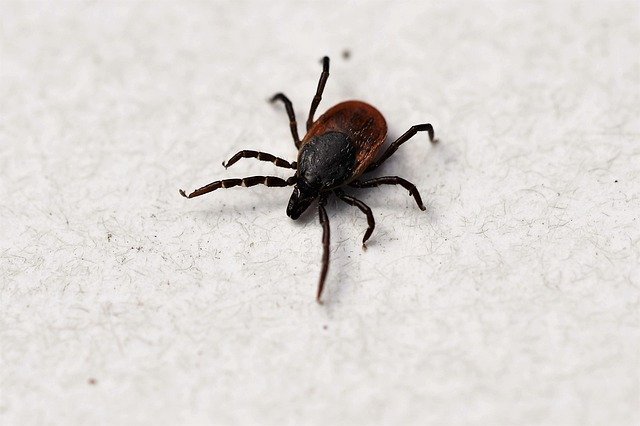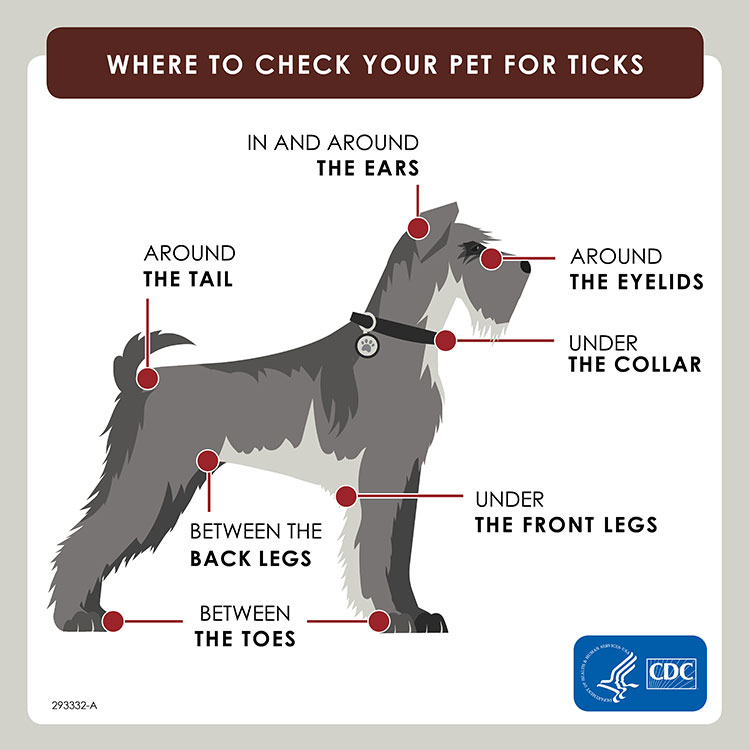Preventing and Treating Ticks for Dogs
Posted: 11/06/2023 | BY: Erin Cain | Categories: Uncategorized
Ticks are an annoying pest that dog owners have to contend with every year. However, ticks are a type of parasite that can cause your dog to become quite ill, and they can even affect you and your family if your dog brings ticks into your home.
As vaccines are not available for many of the tick-borne diseases that a dog may develop, the best way to keep your pup — and your home — tick-free is taking preventative measures against this nasty bug. However, even the best measures can sometimes fail, so it’s essential to know how to identify and remove ticks in case tick prevention methods don’t work. Here’s how to prevent and treat ticks for dogs.
Everything you need to know about ticks for dogs

What are ticks?
Many people mistake fleas and ticks as the same insect when that is not the case at all. Where fleas are six-legged jumping bugs, the eight-legged tick belongs to a completely different, non-insect family: the arachnid. Ticks are closely related to spiders, mites, and scorpions, a similarity that is seen upon closer examination.
Unlike fleas and winged bugs, ticks don’t fly or jump. Instead, they crawl up long blades of tall grass, low brush, leaves, and branches, and extend their front legs to latch onto a passing animal or person, a process known as “questing.” Once the tick has landed on its victim, it embeds its mouth parts into the skin and sucks the animal or person’s blood. Because a tick’s saliva has numbing properties, most hosts never feel the bite. If a tick carries disease, it transmits that infection to its host during this stage of the feeding process.
An adult female tick can lay between 1,500 and 5,000 eggs, prompting the life cycle — egg, larvae, nymph, adult — to begin. Larvae look for blood hosts right away to molt into nymph form. Infected ticks can spread diseases including Lyme disease, anaplasmosis, babesiosis, Rocky Mountain spotted fever, ehrlichiosis, and tularemia. Ticks can feed on their hosts for as little as a few hours to upwards of weeks on end.
There are nine different tick species in North America, and while they live in different regions and environments, they all have one thing in common: they like your dog as a source of food. Here are the nine tick species to be aware of:
- Black-legged tick
- Lone Star tick
- American Dog tick
- Brown Dog tick
- Groundhog tick
- Gulf Coast tick
- Rocky Mountain Wood tick
- Soft tick
- Western Black-legged tick
Studies show that the tick population is increasing due to a variety of factors, including widespread urbanization and an increase in white-tail deer populations. Deer are a favorite host for the Black-legged tick and the Lone Star tick, the two primary carriers of Lyme disease. Climate change has also prompted an increase in ticks as warmer winters mean that ticks don’t go dormant as they would in continuously cold temperatures.
Why are ticks dangerous to dogs?

It isn’t just the gross-out factor of tick bites, or the annoying itchiness that their bite may bring that are problematic for dogs. Unfortunately, like people, dogs can become ill from tick bites, and in some cases, those diseases can be deadly. Multiple tick bites can cause anemia in dogs. Here are some other illnesses dogs can get from tick bites:
Ehrlichiosis
Typically carried by the Brown dog tick, ehrlichiosis affects dogs in stages: acute, sub-clinical, and chronic. Infected dogs can show early signs of infection through sudden weight loss, bleeding disorders, fever, swollen lymph nodes, and neurological imbalances. Chronic ehrlichiosis may lead to anemia, eye problems and blindness, neurological disorders, lameness, and permanent immune system damage.
Rocky Mountain Spotted Fever
A common tick-borne disease found in North America, Rocky Mountain Spotted Fever is potentially deadly to dogs. While some dogs show no symptoms of the disease after contracting it, others can display signs of illness such as lethargy, sudden bleeding, fever, loss of appetite, difficulty breathing, swollen lymph nodes, limbs, or face, shock, coma, and death.
Tularemia
Tularemia is a rare occurrence in dogs, but some canines are susceptible to this disease. Dogs bitten by ticks with this disease may exhibit symptoms such as mild fever, lethargy, lack of appetite, conjunctivitis, swollen lymph nodes, and draining abscesses.
Lyme disease
While only 5 – 10% of dogs infected with Lyme disease show symptoms of the infection, Lyme disease can cause long-term illnesses in our canine companions. Symptoms of this disease include fever, difficulty breathing, depression or behavioral changes, stiffness in posture when walking, lack of appetite, and lameness. Unfortunately, Lyme disease can cause long-term kidney damage which can lead to other medical conditions and even death.
Because ticks are often on the ground, on grasses, in wooded areas, and backyards where dogs walk and play, it’s important to make sure your dog is tick-free as much as possible.
Where can ticks be found on dogs?
Ticks are about as large as the head of a pin, so they can be tough to spot, especially on a furry dog. That’s why some pet parents think if they run a brush through their dog daily, they’ll remove any ticks in long, heavy fur.
Ticks are savvy, though, which is why they tend to avoid thick, hairy locations on your dog for more hairless areas that are easier to bite and feed on. Take care to look at the tick’s favorite spots to latch onto your dog, including: in and around the ears, around the tail, in between the toes, under the front legs, in the genital areas, under the collar or harness, and around the eyes and eyelids. When you look for ticks on your dog, don’t neglect to check each of these areas carefully.

When is “tick season”?
Tick-borne diseases are found in all fifty states. While the so-called “tick season” varies from region to region, it’s important to note that ticks are year-round pests. Knowledge is power, so it’s helpful to know what ticks to look out for and when in your region.

How can you prevent ticks on your dog?
The best way to handle tick bites on your dog is to prevent them from happening at all. Here are some ways to keep your dog, and your family, safe from ticks:
- Use a monthly prescription topical medication that kills ticks.
- Ask your veterinarian about multi-month oral medications that kill fleas and ticks.
- Spray your dog with a canine-safe tick repellent before letting her run or play in a high-risk tick area.
- Have your dog wear a tick collar. Many of these collars offer tick preventatives for three to eight months.
- Inspect your dog carefully every day for ticks. Run your hands over your dog’s skin, taking care to look at the areas ticks like to hide.
- Eliminate tick populations in your yard by keeping your lawn mowed and cutting down tall grasses and weeds.
- Keep your dog away from tick-infested areas, particularly areas with tall grasses and wooded locations.
Some dogs may be allergic to ingredients in topical creams and sprays, so talk with your veterinarian before using these products on your pup.
Doubling or tripling up on preventative care and making daily body checks a habit can cut down on your dog’s chances of tick bites. The bonus is that ticks are less likely to invade your home and look to you and your family as additional hosts.
The do’s and don’ts of removing ticks from your pup
Sometimes, even with preventative check-ups and care, ticks happen. What should you do if you find a tick on your dog?
What to do to remove a tick
- Use clean (preferably sterilized) fine-point tweezers.
- Wear rubber gloves to prevent any infection.
- Work in an area with good lighting, or shine a light on the tick’s location so you can better see it during removal.
- Part your dog’s hair around the tick.
- Take the tweezers or gadget and carefully grasp the head of the tick where it is attached to your dog’s skin.
- Press down slightly to get as close to the skin as you can but do not twist, yank, jerk, or rip the tick out. Those movements may cause the tick to break off with the mouth parts still embedded in the skin, which means your dog can still become infected.
- Pull up steadily and slowly in a perpendicular direction away from your dog’s skin until the tick is detached.
- Place the tick in isopropyl alcohol, then into a sealable plastic bag.
- Clean the bite location and your hands with disinfectant to prevent infection.
- If you are concerned about what disease the tick may carry, you can bring the bagged tick to your veterinarian for further assistance.
If the tweezer process is too involved for you, consider getting a tick removal gadget. This small tool makes the removal process quick and easy.
What to avoid during tick removal
Do not remove the tick with your bare hands as it not only leads to a messy process, but you are likely to squeeze the tick and further inject infection into your dog.
Do not crush, smash, or squish the tick.
Do not attempt to remove the tick with vaseline, nail polish, dish detergent. These are popular myths that won’t remove the tick. In fact, these materials will only make the tick burrow more deeply into your dog’s skin.
Do not attempt to remove the tick by burning it with a match or freezing it off. Only you and your dog will suffer from these methods!
When in doubt, contact your veterinarian for help in removing the tick in a manner that is safe for both you and your pup.
Keep your dog tick-free all year round
Ticks are a year-round danger, and a tick bite can have long-reaching medical consequences for dogs. If you’re worried about the costs of preventative care for your dog, get a quote for a pet insurance policy. Many policies can help you pay for your dog’s care, whether a tick has bitten her or not.
Keeping your dog safe and healthy is always a primary concern for pet parents. With knowledge and daily check-ups, you can make sure your dog is healthy and tick-free all the time.
References:
- Centers for Disease Control and Prevention. (2019). Preventing ticks on your pets. Retrieved from https://www.cdc.gov/ticks/avoid/on_pets.html
- National Pest Management Association. (2020). Interesting Tick Facts. Retrieved from https://www.pestworld.org/news-hub/pest-articles/interesting-tick-facts/
- Bay Area Lyme. (2016). Beware the Questing Tick! Retrieved from https://www.bayarealyme.org/blog/beware-the-questing-tick/
- The Tick App. (n.d.). Tick FAQ. Retrieved from https://thetickapp.org/tick-prevention/tick-faq/
- Koenig, D. (2019). FAQ: All About Ticks 2019. Retrieved from https://www.webmd.com/skin-problems-and-treatments/news/20190702/faq-all-about-ticks-2019
- National Institute of Allergy and Infectious Diseases. (2019). Lyme Disease. Retrieved from https://www.niaid.nih.gov/diseases-conditions/lyme-disease
- Nolen, R. (2020). Tiny ticks. Big threat. Retrieved from https://www.avma.org/javma-news/2020-02-01/tiny-ticks-big-threat
- Ambrose, K. (2019). The tick population is booming. Is climate change to blame? And will tick-borne diseases increase? Retrieved from https://www.washingtonpost.com/weather/2019/05/22/tick-population-is-booming-is-climate-change-responsible-will-tick-borne-disease-increase/
- Revival Animal Health. (2020). Effective Tick Prevention for Dogs. Retrieved from (https://www.revivalanimal.com/pet-health/dont-let-ticks-overwhelm-you/learning-center
- Llera, R., Ward. E. (n.d.). Ehrlichiosis in Dogs. Retrieved from https://vcahospitals.com/know-your-pet/ehrlichiosis-in-dogs
- Clark, M. (2020). Rocky Mountain Spotted Fever in Dogs. Retrieved from https://dogtime.com/dog-health/56635-rocky-mountain-spotted-fever-dogs-symptoms-causes-treatments
- Canna-Pet. (n.d.) Tularemia in Dogs: A Guide. Retrieved from https://canna-pet.com/tularemia-in-dogs-a-guide/
- Gallant.com. (2019). Lyme Disease in Dogs: The Facts. Retrieved from https://gallant.com/blog/lyme-disease-dogs-facts/
- Pests.org. (2020). 2020 Tick Forecast. Retrieved from https://www.pests.org/2019-tick-forecast/
- Skerrett, P. (2013). Matchless strategy for tick removal; 6 steps to avoid tick bites. Retrieved from https://www.health.harvard.edu/blog/matchless-strategy-for-tick-removal-6-steps-to-avoid-tick-bites-201306076360
Disclaimer
The information contained on this blog is intended for informational and educational purposes only and should not be construed as medical advice. It is not a substitute for professional veterinary care. Always consult with your veterinarian before making any changes to your pet's health care or treatment plan.
The authors of this blog are not veterinarians and do not claim to be experts in pet health. The information provided here is based on our own experiences and research, as well as information from reputable sources. However, we cannot guarantee the accuracy or completeness of this information.
We encourage you to do your own research and consult with your veterinarian before making any decisions about your pet's health.
Previous post
True Petventures: Roxie's StoryCompare top pet insurance providers & plans.
Enter your dog’s age in years and months to calculate their age equivalent to human years.
Calculate your dog’s ageEnter your cat’s age in years and months to calculate their age equivalent to human years.
Calculate your cat’s age